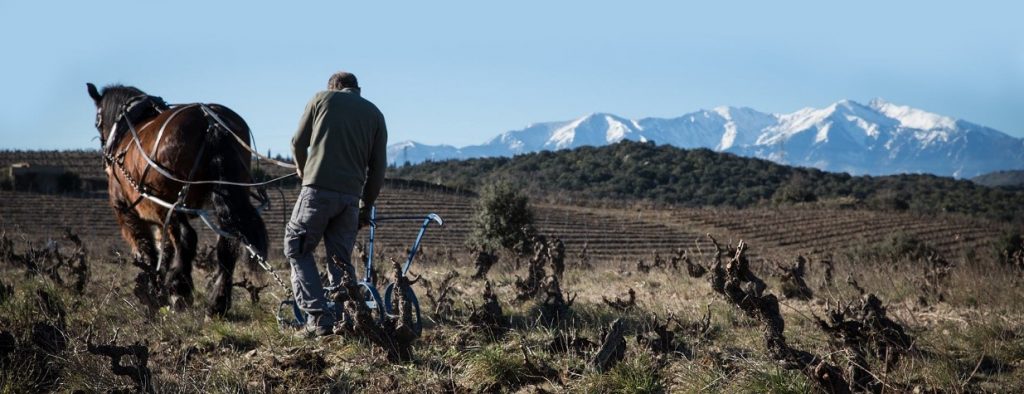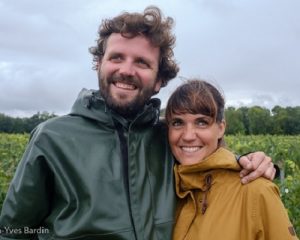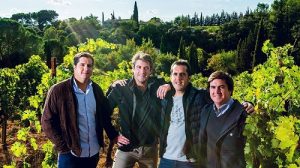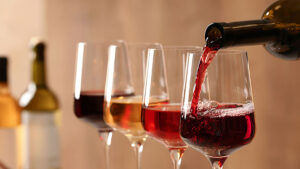
The story of this domain, nestled at the foot of the Pyrenees, began in an unusual way: during a game of cards almost two centuries ago. Olivier Decelle now works on over 152 hectares of vines with his team. We were lucky enough to speak with Nicolas Raffy about this icon of the Maury appellation.
It was the winning of a card game that saw an engineer, Raymond Etienne Amiel, win the land of Domaine de Goudous from the Bishop of Perpignan. This ten-hectare vineyard in an area of scrubland thus very quickly changed hands in the year 1816, naturally undergoing a change of name at the same time. This was how Mas Amiel came to be, and since then three families have gone on to run the domain. It was the Gouzy family who picked the vineyard up after the phylloxera crisis. Then, in 1907, the Dupuy family had their turn, with Charles Dupuy successfully managing to spread the name of Mas Amiel beyond its immediate periphery. And in 1999, it was Olivier Ducelle who fell for the charms of this property, and he is still there today working the 226 hectares of land, 155 of which are planted with vines.
When Olivier took over Mas Amiel, it was during an era strongly led by the production of naturally sweet wines in Maury, a method that had been prevalent there since the 1930s. Having a good look at the vineyards and viewing them in a different light, the team realised that the terroir had the potential for producing really good quality dry wines due to the richness of the soil. They were even optimistic of gaining global renown. The crafting of this kind of wine had been especially widespread in the Middle Ages as well as during the 19th century. From their arrival on the domain, the team made it their mission to create an AOC in Maury for the making of dry wines. This eventually came to pass in 2011, with the Légende du Mas Amiel cuvée crafted to inaugurate the occasion. Olivier also believed in the importance of officially converting the domain to organics and biodynamics, though it is worth noting that these methods have been practiced at Mas Amiel for some time already. “This is was step we need to take for the sake of transparency and respect towards out clients”, explains Nicolas Raffy, the domain’s oenologist. With official organic certification confirmed in 2017, 2020 will be the year of biodynamics. “The idea here is not to heal something but rather to foresee, as we have always done at Mas Amiel. We try to read into the nature around us, listening and understanding rather than restricting”. This is why the 22 people who work there are split into small groups, with each one assigned specific parcels. Organising in this way allows for consistency in the work carried out on the vineyards, as well as a deep understanding of the earth and its particularities.
There are now around 152 hectares of vines planted on 130 parcels, and the grape varieties grown are Grenache, Grenache Passerillé, Maccabeu, Carigan, Syrah, Muscat and Grenache Gris. Horses are sometimes used to support the manual labour in the vineyards since the oldest and youngest vines require quite precise work that can’t always be carried out in a tractor. Working without machinery also avoids the compacting of the earth, allowing the soil to breathe. The harvests are carried out manually, “as a way of being as close as possible to our land, which is why we have a team of 120 workers for 1-2 months of the year”. These grapes are then transported in small, 15kg cases in order to preserve the quality of the fruit.
Mas Amiel produces three ranges of wine:
- Dry wines (red and white): part of the AOC, these wines are vinified separately in order to preserve the individual character of each terroir. The maturation of these wines happens in small barrels of 15, 40 or 45 hectolitres. For some of these wines, the idea is to highlight the qualities of parcels that each produce very different cuvées.
- Sweet wines: these are fortified wines made to be enjoyed in their youth. The goal of the vinification is to keep the wines balanced and fresh. The fortification takes place in the presence of grape must and is followed by a maceration that lasts around 30 days. After this, the wines spend their first winter in vats.
- Oxydative sweet wines: after fortification, these wines are placed in glass carboys (a kind of large, round bottle). This happens in June, and they’re kept outside for a whole year. The glass means that both light and temperature have an effect on the wine. The carboys have stoppers in them just to prevent insects from getting inside, but this lets air in to work on the wine. After quiet a harsh year outdoors, the wines are placed in huge, 60-litre barrels. They have a long maturation waiting for them, usually between 20 and 40 years, meaning that it’s often the job of the next generation of wine makers to “browse the rich library and create blends that will finally be put to the market”.



